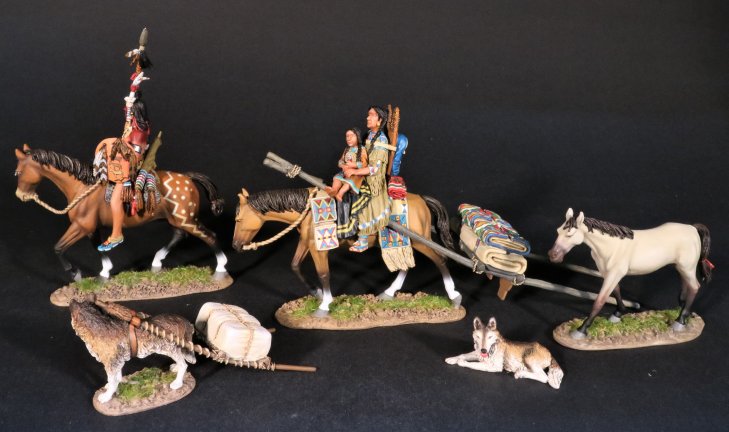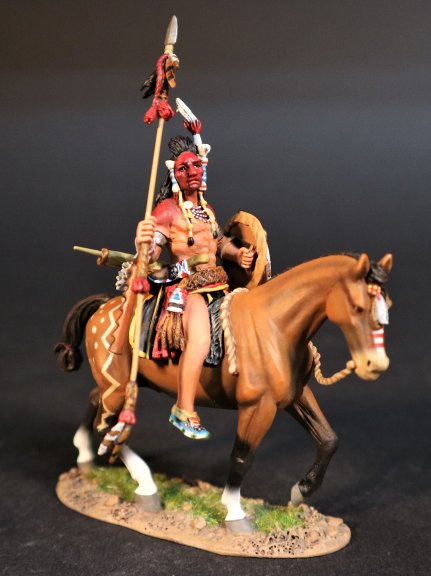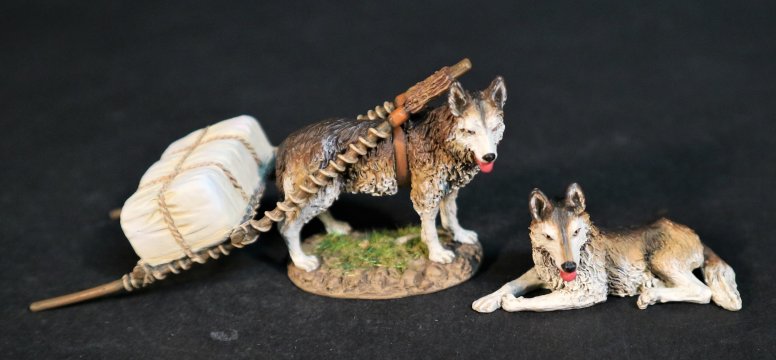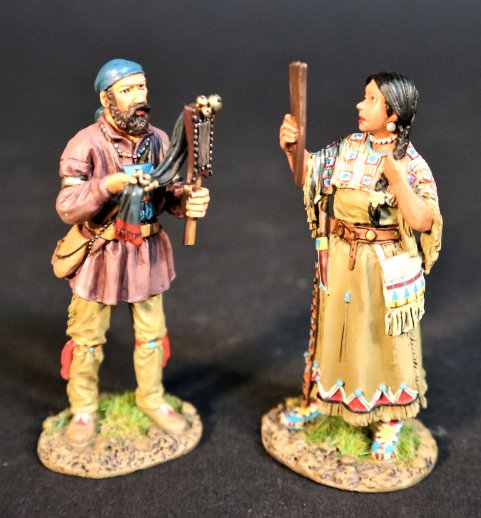- Joined
- Feb 2, 2011
- Messages
- 2,093
NEW RELEASES FOR SEPTEMBER 2022
THE FUR TRADE

A Travois is a frame structure that was used by the plains Indians of North America, to drag loads over land. There is evidence to support that travois were used in other parts of the world before the invention of the wheel.
Initially the travois was pulled by dogs. The basic dog travois consisted of two aspen or cottonwood poles, notched and lashed together at one end with buffalo sinew, with the other ends splayed apart.
Cross bars are lashed between the poles near the splayed ends, and the finished frame looks like a large letter A with extra cross bars.
The apex of the A, wrapped in buffalo skin to prevent friction burns, rests on the dog’s shoulders, whilst the splayed ends drag over the ground.
Women both built the travois and managed the dogs. Buffalo meat and firewood were typical travois loads.
Although the dog travois were small, they were capable of pulling up to 20-30kg. In hot weather travel was slower as it was more tiring for the dogs. Dog travois can be seen in the paintings of Karl Bodmer.

WSP-09
THE FUR TRADE,
THE CROW,
CROW WARRIOR.
(2 pcs)
By the mid 18[SUP]th[/SUP] Century, the dog travois had given way to the horse travois.
When dogs were replaced by horse, the greater pulling power allowed trips to increase in size and household goods to multiply.
Instead of specially constructed sleds, the plains Indian tribes would simply cross a pair of tepee poles, across the back of the horse, and attach a burden platform between the poles behind the horse.
This served two purposes at once, as the horses could then simultaneously carry the tepee poles and some additional baggage. Children often were able to ride in the back of the horse travois.

WSP-11
THE FUR TRADE,
THE CROW,
2 DOGS WITH TRAVOIS.
(3 pcs)
Some tribes it was also traditional to leave the tepee poles behind at the old camp, for use by the next tribe or family to camp there.
MOUNTAIN MEN – THE RENDEZVOUS
A mountain man was an explorer who lived in the wilderness. They were instrumental in opening up the various Emigrant Trails (widened into wagon roads) allowing Americans in the east to settle the new territories of the far west by organized wagon trains traveling over roads explored and in many cases, physically improved by the mountain men and the big fur companies originally to serve the mule train based inland fur trade.
Mountain men were most common in the North American Rocky Mountains from about 1810 through to the 1880s (with a peak population in the early 1840s). Approximately 3,000 mountain men ranged the mountains between 1820 and 1840, the peak beaver-harvesting period. While there were many free trappers, most mountain men were employed by major fur companies. The life of a company man was almost militarized. The men had mess groups, hunted and trapped in brigades and always reported to the head of the trapping party.
This man was called a "boosway", a bastardization of the French term bourgeois. He was the leader of the brigade and the head trader.
The Mountain men represents the “Beaver Pelts” of the original WSP title, and is the smallest part of the series, as it mainly concentrates on the individual men and personalities that worked alone or in pairs in the mountain wilderness.

WSP-55
THE FUR TRADE,
THE ROCKY MOUNTAIN RENDEZVOUS,
“NEW SHINY, SPARKLY LITTLE THINGS!”.
(2 pcs)
** PLEASE CONTACT YOUR LOCAL DEALER FOR FURTHER INFORMATION **
THE FUR TRADE

A Travois is a frame structure that was used by the plains Indians of North America, to drag loads over land. There is evidence to support that travois were used in other parts of the world before the invention of the wheel.
Initially the travois was pulled by dogs. The basic dog travois consisted of two aspen or cottonwood poles, notched and lashed together at one end with buffalo sinew, with the other ends splayed apart.
Cross bars are lashed between the poles near the splayed ends, and the finished frame looks like a large letter A with extra cross bars.
The apex of the A, wrapped in buffalo skin to prevent friction burns, rests on the dog’s shoulders, whilst the splayed ends drag over the ground.
Women both built the travois and managed the dogs. Buffalo meat and firewood were typical travois loads.
Although the dog travois were small, they were capable of pulling up to 20-30kg. In hot weather travel was slower as it was more tiring for the dogs. Dog travois can be seen in the paintings of Karl Bodmer.

WSP-09
THE FUR TRADE,
THE CROW,
CROW WARRIOR.
(2 pcs)
By the mid 18[SUP]th[/SUP] Century, the dog travois had given way to the horse travois.
When dogs were replaced by horse, the greater pulling power allowed trips to increase in size and household goods to multiply.
Instead of specially constructed sleds, the plains Indian tribes would simply cross a pair of tepee poles, across the back of the horse, and attach a burden platform between the poles behind the horse.
This served two purposes at once, as the horses could then simultaneously carry the tepee poles and some additional baggage. Children often were able to ride in the back of the horse travois.

WSP-11
THE FUR TRADE,
THE CROW,
2 DOGS WITH TRAVOIS.
(3 pcs)
Some tribes it was also traditional to leave the tepee poles behind at the old camp, for use by the next tribe or family to camp there.
MOUNTAIN MEN – THE RENDEZVOUS
A mountain man was an explorer who lived in the wilderness. They were instrumental in opening up the various Emigrant Trails (widened into wagon roads) allowing Americans in the east to settle the new territories of the far west by organized wagon trains traveling over roads explored and in many cases, physically improved by the mountain men and the big fur companies originally to serve the mule train based inland fur trade.
Mountain men were most common in the North American Rocky Mountains from about 1810 through to the 1880s (with a peak population in the early 1840s). Approximately 3,000 mountain men ranged the mountains between 1820 and 1840, the peak beaver-harvesting period. While there were many free trappers, most mountain men were employed by major fur companies. The life of a company man was almost militarized. The men had mess groups, hunted and trapped in brigades and always reported to the head of the trapping party.
This man was called a "boosway", a bastardization of the French term bourgeois. He was the leader of the brigade and the head trader.
The Mountain men represents the “Beaver Pelts” of the original WSP title, and is the smallest part of the series, as it mainly concentrates on the individual men and personalities that worked alone or in pairs in the mountain wilderness.

WSP-55
THE FUR TRADE,
THE ROCKY MOUNTAIN RENDEZVOUS,
“NEW SHINY, SPARKLY LITTLE THINGS!”.
(2 pcs)
** PLEASE CONTACT YOUR LOCAL DEALER FOR FURTHER INFORMATION **

